This document introduces AngularBeans, which aims to integrate AngularJS with Java EE backends using CDI. Some key points: - AngularBeans allows defining Angular services using CDI beans, and enables features like dependency injection, JSON-RPC calls, and real-time capabilities between the frontend and backend. - It supports concepts of single-page applications and thin server architectures. AngularBeans services can make HTTP requests, handle events, and communicate over websockets. - Examples show how to create an AngularBean that exposes methods to the frontend, handle requests and return responses, access the backend via JSON-RPC calls, and implement real-time functionality using events and websockets.








![JSON/JSON RPC { { "is": ["compact", "readable"] "web_service": "JS native object" "enough" : "for majority of needs" } }](https://image.slidesharecdn.com/angularbeans-150621011037-lva1-app6892/75/Angular-beans-9-2048.jpg)













![<!DOCTYPE html> <html> <head> <script type="text/javascript" src="bower_components/angularjs/angular.js"></script> <script type="text/javascript" src="angular-beans.js"></script> <script type="text/javascript"> var myApp = angular.module("myApp", [ "angularBeans" ]); myApp.controller('calcCtrl', function($scope, calcBean) { $scope.clacBean = calcBean; }); </script> </head> AngularBeans : my first bean (style 1) :HTML module generated by AngularBeans CalcBean is now an injectable service](https://image.slidesharecdn.com/angularbeans-150621011037-lva1-app6892/75/Angular-beans-23-2048.jpg)



![AngularBeans : my first bean (style 2) :HTML <script type="text/javascript"> var myApp = angular.module("myApp", [ "angularBeans" ]); myApp.controller('calcCtrl', function($scope, calcBean) { $scope.add = function(a,b) { calcBean.add(a,b).then(function(data){ $scope.result=data; } ); } }); </script>](https://image.slidesharecdn.com/angularbeans-150621011037-lva1-app6892/75/Angular-beans-27-2048.jpg)

![AngularBeans : my first bean (with binding) :HTML <script type="text/javascript"> var myApp = angular.module("myApp", [ "angularBeans" ]); myApp.controller('calcCtrl', function($scope, calcBean) { angularBeans.bind($scope,calcBean,["result"]); }); </script> Scope will be auto synchronized with the bean proxy (the service) state, this function take as argument an array of the properties to be bound, in this case « result » is the main return so we must add @NGReturn(model="result") on the add() method of the bean](https://image.slidesharecdn.com/angularbeans-150621011037-lva1-app6892/75/Angular-beans-29-2048.jpg)





![AngularBeans : my first bean (ModelQuey) :HTML myApp.controller('calcCtrl', function($scope, calcBean) { angularBeans.bind($scope,calcBean,["result","messages","time"]) ; }); <h2>Result: {{result}}</h2> <ul ng-repeat="m in messages"> <li>{{m.summary}} - {{m.detail}}</li> </ul> {{time}}](https://image.slidesharecdn.com/angularbeans-150621011037-lva1-app6892/75/Angular-beans-35-2048.jpg)


![myApp.controller('calcCtrl', function($scope, calcBean) { angularBeans.bind($scope,calcBean,["result","messages" ,"time"]); $scope.$on("calculationEvent",function(event,data){ alert(data.notification); }); }); AngularBeans : my first bean real time & events](https://image.slidesharecdn.com/angularbeans-150621011037-lva1-app6892/75/Angular-beans-38-2048.jpg)


